|
The situation of the former slaves About four million former slaves were freed during or just after the Civil War. The vast majority, like the family shown on the right, were in the Southern states. Most freed slaves - called freedmen - had no education, no money, and owned no land or farming tools. So the most immediate problem facing the president and leaders in Congress was getting food and other help to the freed slaves. In response to that need, President Lincoln created a new federal government agency called the Freedmen's Bureau. |
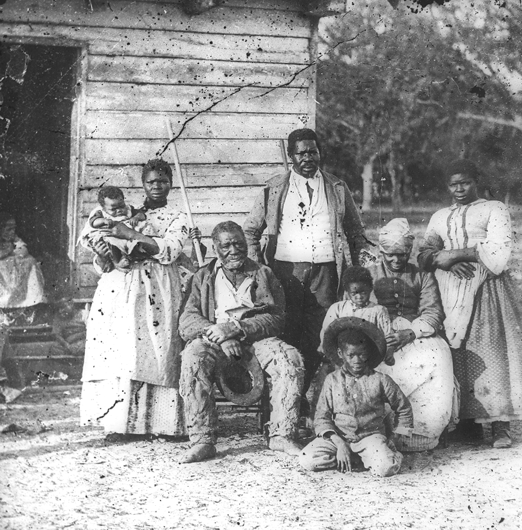 |
|
A Freedmen's
Bureau was opened
in Richmond, Virginia The drawing below is from a newspaper of 1866. It shows the Freedmen's Bureau office that opened in Richmond, Virginia. African Americans living in the city, most of whom were freed slaves, are lining up to receive emergency supplies of food. Hundreds of Freedmen's Bureau offices were opened all across the South. |
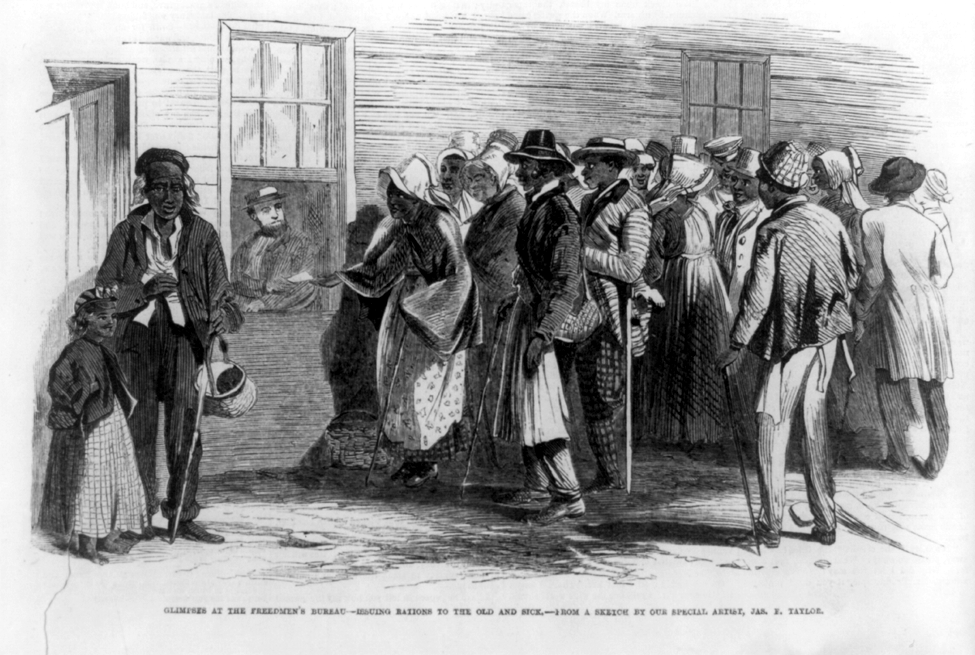
|
The Freedmen's
Bureau
schools
The Freedmen's Bureau also created schools for the freed slaves and their children. This newspaper drawing shows a Freedmen's Bureau school in Richmond. Some of the teachers in these schools were from Northern states, but others were whites and blacks from the South. |

|
Problem # 2: As Reconstruction began, Southern states created laws called Black Codes that restricted the rights of the freed slaves. Policy of the federal government: Congress passed the Civil Rights Act of 1866 to stop the Black Codes and guarantee equal rights for the freedmen. |
|
What did
the Black Codes do?
Black Codes were state laws that put restrictions on the rights of blacks. Most whites in the South were simply not willing to suddenly accept the freed slaves as equals or as full citizens. (This attitude was fairly widespread even in the North at that time.) The Black Codes varied from state to state. Overall, however, they put the freedmen in an unequal legal status compared to whites. The laws typically said blacks could not vote in elections. Some required the freedmen to sign work contracts with farm owners, or they could be arrested. The drawing shows a freedman plowing land on a farm in South Carolina in 1866. |
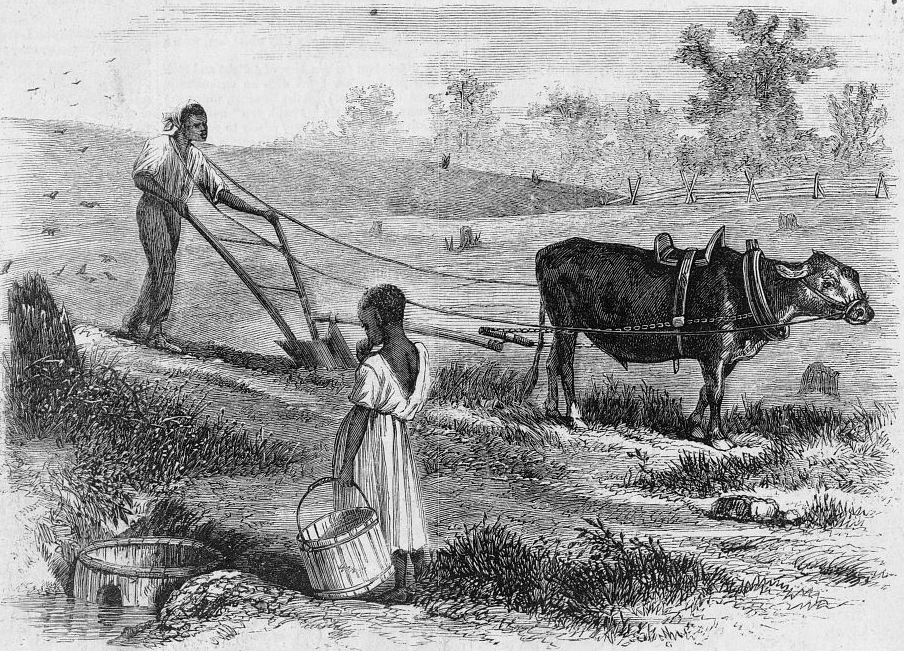
|
The Civil Rights Act of 1866 ended the Black Codes In response to the Black Codes, the U.S. Congress passed a law called the Civil Rights Act of 1866. This national law was aimed at protecting the civil rights of the freed slaves. Civil rights is a term for the normal rights of a citizen - including the right to buy and sell property, take a legal case to court, be treated equally under the laws, and to be free from unfair discrimination. The Civil Rights Act of 1866 declared that everyone born in the U.S. is a citizen, regardless of race or color. It then listed the basic civil rights that must be recognized in all the states for all citizens. This new law ended the Black Codes, since a national law is higher than a state law. It helped African Americans achieve legal equality with whites. |
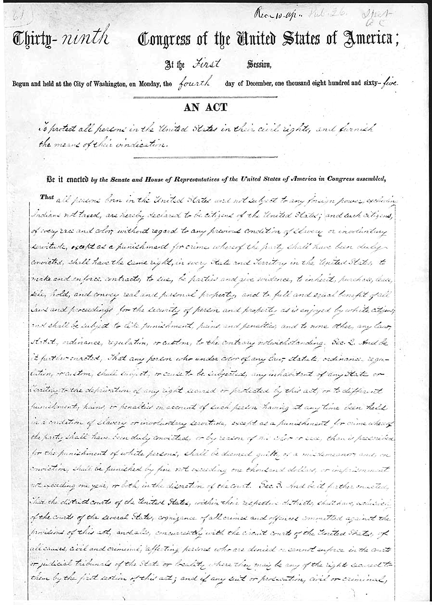 |
|
Use military force, if necessary!
One part of the Civil Rights Act of 1866 said the government could send federal troops (Northern soldiers) back into the South if necessary to make sure the new law was being followed. That is exactly what the government did, the very next year. In 1867 Congress voted to divide the Southern states into five military districts. A Union general was put in charge of the government of each district. During most of the years of Reconstruction, federal troops controlled and supervised the South. The main goal of this action was to protect the rights of the freed slaves. The map shows how the Southern states were divided up into the military districts. |
|
Problem # 3: The former slaves were not being allowed to vote in elections. Policy of the federal government: Federal troops will make sure the freedmen can vote, but former Confederate leaders will not be allowed to vote. |
The new
voting
policy
created resentment Once federal troops were sent back into the South, the freedmen's right to vote in elections and run for public office was protected. Former Confederate military leaders, however, were not allowed to vote or hold public office. Many whites in the South complained bitterly about this policy. They argued that most of the freedmen had no idea what they were voting for, and were easily tricked by dishonest candidates. This drawing from an 1867 newspaper shows a group of black men voting for the first time. Later, whites in some areas tried to stop blacks from voting by creating secret organizations like the Ku Klux Klan. These groups often used violence to threaten blacks who tried to vote. |
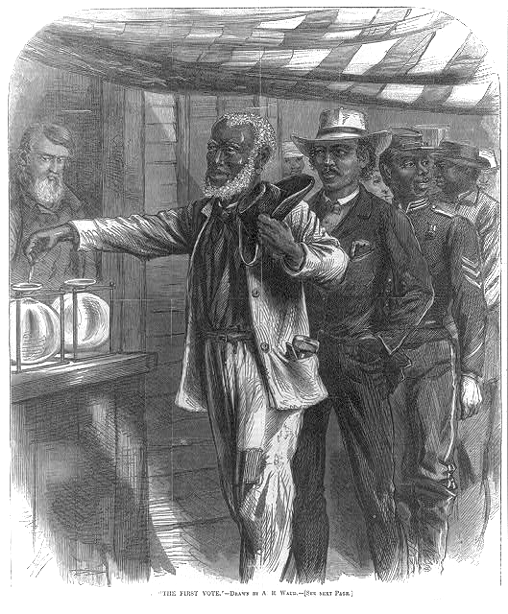 |
|
New faces in
the seats of power
As a result of the voting policy enforced by federal troops, Southern blacks began winning elections for seats in state governments and in the U.S. Congress. Many were men who had been free blacks before the Civil War, and had some education and knowledge of politics. The drawing below shows some of the first African Americans to win elections for seats in the U.S. Congress. |

|
Problem # 4: Some Northerners moved into the South after the Civil War, sometimes to take advantage of the South. They were hated by Southerners and called "carpetbaggers." |
|
Why were
they called carpetbaggers?
The term "carpetbaggers" comes from a type of cheap luggage sometimes carried by Northerners who came South during Reconstruction. The suitcases were mostly made of carpet cloth. A common complaint was that carpetbaggers would find desperate people in the South and buy their farm or business at unfairly low prices. Another complaint was that carpetbaggers would win elections for political office by tricking freed slaves with false promises. Most whites in the South considered carpetbaggers as no better than rats. The political cartoon below shows a greedy looking man as a carpetbagger. There were no policies that could deal with this kind of problem, which unfortunately is often found in many countries just after a war ends. There were, however, many Northerners who came into the South for good purposes, such as to start new businesses, for example, or to become teachers. |

|
Looking deeper: Did these policies help? The Reconstruction policies certainly did not solve all of the problems left at the end of the Civil War. It is hard to imagine any list of policies that could have solved everything. What is truly amazing is that there were so many Americans who were willing to try. At that time, there were hardly any places on Earth where idea of the equality of all races and people was widely accepted. It was here, in the United States, where so many leaders and citizens pushed to get that idea firmly set in law. The drawing shows a black family near Richmond, Virginia, that did create a new life for themselves in that difficult time. Look at the the man and his wife, and the home they have made for themselves. Whatever hardships they faced, they knew that slavery's days were gone forever. They knew that the future held at least the promise of something better. |
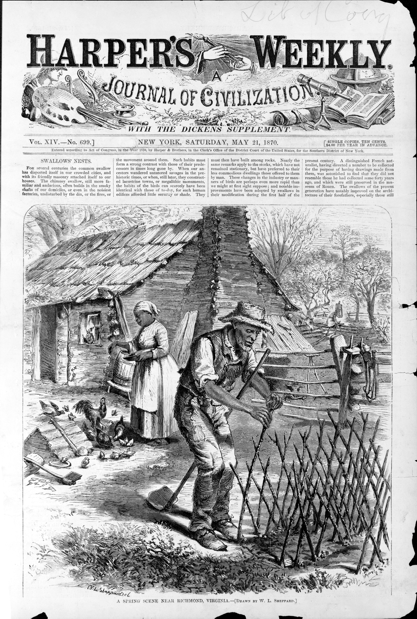 |